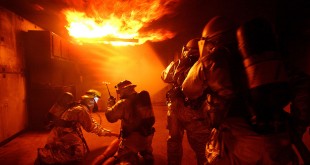IED’s have become an extremely significant and dangerous force protection issue in the wake of Operation Iraqi Freedom (OIF) and the Global War on Terror (GWOT). Insurgents and terrorists are using a variety of asymmetric techniques to attack militarily superior coalition forces with military ordnance components combined with commercial off …
Read More »New detection technologies tracking terrorists through thick concrete, underground tunnels, and caves
In April 2017, the U.S. military dropped the most powerful non-nuclear bomb ever used in combat on a tunnel complex in Afghanistan’s Nangarhar province. The airstrike targeted the Islamic State’s Khorasan branch. The use of the GBU-43/B Massive Ordnance Air Blast weapon, the so-called “Mother of All Bombs,” highlighted the …
Read More »Militaries employing UAV swarms under Network Centric Electronic Warfare concept to counter A2/AD environment
All modern forces depend on unimpeded access to, and use of, the EM spectrum in conducting military operations. Therefore, there is a requirement to gain and maintain an advantage in the electromagnetic spectrum by countering adversary’s systems and protecting one’s own systems. Electronic Warfare has become now a means to …
Read More »Autonomous take-off and Landing technologies to allow UAVs to operated in tactical battlefield and integrate into National Air Space
An unmanned aerial vehicle (UAV) ( commonly known as a drone) is an aircraft without a human pilot on board. UAVs are a component of an unmanned aircraft system (UAS); which include a UAV, a ground-based controller, and a system of communications between the two. The flight of UAVs may …
Read More »DARPA calls for Neurological and Internal Organ Regeneration Biotechnology for wounded warriors
Some parts of our bodies can repair themselves quite well after injury, but others don’t repair at all. We certainly can’t regrow a whole leg or arm, but some animals CAN regrow – or regenerate – whole body parts. So what can we learn from these regenerative animals? Regeneration means …
Read More »Rapid rise in drone operations require optimal mission-planning, Traffic Management, and drone management software
Drones are increasingly making an impact on society and economy. Drones are used by the military for intelligence gathering, anti-aircraft target practice, and also for weapons platforms. They are also used for many civilian roles such as agricultural surveillance, mapping, tracking, search and rescue, traffic monitoring, firefighting, weather monitoring, engineering …
Read More »Sense and Avoid (SAA) technologies for Safe integration of Unmanned Aircraft Systems (UAS) into Civil Airspace
Unmanned Aerial Vehicles (UAVs) are growing at frentic pace driven by civil, consumer and military requirements. In order for a UAS to safely navigate in the already crowded aerial environment of the modern world, the U.S. Federal Aviation Administration (FAA) and other international organizations have mandated that unmanned aircraft must …
Read More »US adding space-based computing and analytic capabilities to Space Sensors for Ballistic and Hypersonic missile defence
US, Russia and China are in race for Hypersonic Weapons that shall provide prompt global strike capability. Russia’s Avangard hypersonic missile system became operational in Dec 2019, defence minister Sergey Shoygu has said. The intercontinental weapon can fly 27 times the speed of sound and, unlike a regular missile warhead, …
Read More »Military developing Free Space Optical(FSO) or Laser communications for ultrafast secure communications that are harder to detect and disrupt
Free Space Optical or Laser communications is creating a new communications revolution, that by using visible and infrared light instead of radio waves for data transmission is providing large bandwidth, high data rate, license free spectrum, easy and quick deployability, low mass and less power requirement. It also offers low …
Read More »New technologies enable Very Long Range Air-to-Air missiles to reach targets at longer ranges, with heavier payloads and with greater precision
The Air-to-Air Missile (AAM) is a potent guided missile that changed the shape of aerial combat forever. Capable of destroying fast and maneuverable jet fighters at ranges sometimes exceeding 100 kilometers, these high-tech weapons dominate the skies. The probability of Aerial dogfights are becoming less in modern times, as US …
Read More » International Defense Security & Technology Your trusted Source for News, Research and Analysis
International Defense Security & Technology Your trusted Source for News, Research and Analysis









